ATTN:
America Vs Japan: School Lunches
Japan's unbelievable school lunches are surprisingly educational.
Posted by ATTN: on Friday, March 23, 2018
Read About The Tarbaby Story under the Category: About the Tarbaby Blog
ATTN:
America Vs Japan: School Lunches
Japan's unbelievable school lunches are surprisingly educational.
Posted by ATTN: on Friday, March 23, 2018
Dylan Stableford, Senior Editor March 24, 2018

Hundreds of thousands of people are taking part in March for Our Lives demonstrations around the world on Saturday to call for an end to gun violence. The protests were sparked by a string of deadly school shootings, including the massacre in Parkland, Fla., last month. Organizers say they expect nearly a million in Washington, D.C., alone. Yahoo News is covering the events live from the nation’s Capitol and several other locations. Watch a livestream in the video player above and follow the blog below for the latest updates.
Protesters fill Pennsylvania Avenue during the “March for Our Lives” rally in Washington, D.C., on Saturday. (AP Photo/Jose Luis Magana)
Kelli Grant
A protester displays a sign at the “March for Our Lives” rally in Washington, D.C., on Saturday. (Aaron P. Bernstein/Reuters)

The cover of next week’s @Time magazine. https://t.co/ee5AOww0Eo

Kelli Grant
Former Beatle Sir Paul McCartney joins the “March For Our Lives” rally in New York City on Saturday. (Shannon Stapleton/Reuters)

Kelli Grant
Young girls wave down at marchers from the balcony of the Newseum building as students and gun control advocates hold the “March for Our Lives” rally in Washington, D.C., on Saturday. (Leah Millis/Reuters)

Kelli Grant
Protesters gather for the “March for Our Lives” rally along Pennsylvania Avenue in Washington, D.C., on Saturday. (Chip Somodevilla/Getty Images)

Christina Gregg #MarchForOurLives protesters steadily funneling down Central Park West. https://t.co/xZvyw5PgZC

Kelli Grant
Protesters gather for a “March For Our Lives” rally outside the U.S. Embassy in London. (Stefan Rousseau/PA Images via Getty Images)

Kelli Grant
Activists wear red robes and white bonnets based on “The Handmaid’s Tale” before the “March for Our Lives” rally in downtown Houston, Texas, on Saturday. (Loren Elliott/Reuters)

Dylan Stableford: “My sister doesn’t have a voice anymore because she was slaughtered in her classroom.”
— Carlos Soto, whose sister, Victoria Soto, a teacher at Sandy Hook Elementary School, was killed in the 2014 massacre in Newtown, Conn., speaks to CNN at the “March for Our Lives” rally in Washington, D.C.
Kelli Grant
American students and expats hold signs in a solidarity rally with “March For Our Lives” in front of the European headquarters of the United Nations, in Geneva, Switzerland. (Martial Trezzini/Keystone via AP)

Eric Schall March 23, 2018
 Trump has not saved many U.S. jobs from outsourcing since taking office, the record shows. | Mandel Ngan/AFP/Getty Images
Trump has not saved many U.S. jobs from outsourcing since taking office, the record shows. | Mandel Ngan/AFP/Getty Images
You may remember these words from Donald Trump when he was running for president: “A Trump administration will stop the jobs from leaving America.” But U.S. companies sent thousands of jobs overseas in his first year as president. And many of the companies responsible for offshoring jobs received fat government contracts. In fact, according to employment data charted by Good Jobs Nation and Public Citizen, federal contractors alone outsourced 10,269 jobs while taking over $19 billion in government money.
Never before in U.S. history have federal contractors sent so many jobs overseas. Here are the contractors that are offshoring the most jobs under Donald Trump, including parent company of Carrier (page 7).
1. General Motors
These veterans have seen what assault-style weapons can do in combat, and they want them off the streets
These veterans have seen what assault-style weapons can do in combat, and they want them off the streets
Posted by NowThis Politics on Friday, March 23, 2018
Keep a beehive in your house.
Keep a beehive in your house.
Posted by Thrillist on Thursday, February 22, 2018
Would the world be better off if money didn't exist?
Posted by What.If on Friday, March 23, 2018
By Brian Naylor March 23, 2018
 The U.S. government says Russian government hackers have targeted and gained access to U.S energy computer networks. Rich Pedroncelli/AP
The U.S. government says Russian government hackers have targeted and gained access to U.S energy computer networks. Rich Pedroncelli/AP
When President Trump phoned Russian President Vladimir Putin to congratulate him on his re-election Wednesday, Trump made no mention of one of the latest irritants between Russia and the West — his administration’s announcement that Russia successfully hacked the U.S. power grid.
The Department of Homeland Security and the FBI issued a joint alert last week: “Russian government cyber actors” have been targeting U.S. critical infrastructure sectors, including energy, nuclear and commercial facilities, since at least March 2016.
The announcement came the same day that the U.S. imposed sanctions against 19 Russian individuals and five entities for interfering in the 2016 election and for other cyber-intrusions.
James Lewis, a cybersecurity expert and vice president of the Center for Strategic and International Studies, said the news that Russia penetrated the energy grid does not exactly come as a surprise.
“The Russians have been doing this for years,” Lewis said. “The change is that the U.S. government came out and said the Russians hacked the utilities.”
The government informed electric companies last summer that Russia undertook what DHS calls a “multistage intrusion campaign” against the utilities, using common hacking techniques such as malware and spear-phishing. The hackers were able to gain access to at least one power plant’s control system.
 The Department of Homeland Security was able to reconstruct screenshot fragments of a human machine interface that was accessed. US-CERT/Department of Homeland Security
The Department of Homeland Security was able to reconstruct screenshot fragments of a human machine interface that was accessed. US-CERT/Department of Homeland Security
“They were not simply looking around that system and reconnoitering it,” Joel Brenner, head of counterintelligence under the Director of National Intelligence in the Obama administration, told NPR. “They were placing the tools that they would have to place in order to turn off the power. That’s a serious vulnerability for us, and we’re not anywhere near ready to deal with it.”
The Russians have targeted other countries’ electrical grids, most notably Ukraine in 2015, disrupting power for more than 200,000 people.
Scott Aaronson, vice president of security and preparedness at the Edison Electric Institute, which represents the nation’s electric companies, said U.S. power companies have tried to learn from that attack.
Can Americans feel confident the U.S. grid is protected?
“Very much so,” Aaronson said. “The electric power sector takes a lot of different measures to protect our systems.”
That includes operating power plants without digital controls, just like in the old days, he said.
“I tell people one of the best ways to protect against a cyberthreat is to not rely on cyber assets,” Aaronson said, adding that the U.S. power grid “operated for the better part of the last century” without digital controls.
He also said utilities can “go back to a less-efficient means of operating but still keep the lights on.”
Some power companies also block emails and other Internet traffic from outside the country.
But protecting the grid is complicated because of its decentralized nature, with public utility commissions in 50 states exercising some control.
Critics say the Trump administration needs to take stronger steps to block these kinds of attacks from Russia. At a hearing Tuesday, Sen. Maria Cantwell, D-Wash., called the DHS alert a siren.
“Our energy infrastructure is under attack,” Cantwell said. “It’s under cyberattack, and we need to do much more to protect it as a national critical asset.”
Cantwell wants the Trump administration to do an assessment of Russian cyberattacks against the electric grid. The Department of Energy is establishing an Office of Cybersecurity, Energy Security, and Emergency Response, which will focus on energy infrastructure security.
But any retaliation in response to Russia’s cyber-incursion would be up to Trump.
But, as Brenner points out: “The president has not so far shown any inclination or any backbone in confronting repeated Russian provocations. And one can only ask why that is.”
Brenner added that Putin is “playing jiu-jitsu with us.”
“Nobody wants a war,” he said, adding the hostilities taking place now “are in the gray space between war and peace.”
CSIS’ Lewis said that absent a strong U.S. response to the Russian cyber-incursions though, Russia is likely to continue its behavior.
“The problem here is if we don’t give the Russians the idea that doing something to us is bad, they may be tempted to do it,” Lewis said.
And while sanctions can function as somewhat of a deterrent to further intrusions, they may not be enough.
The wealthy corporations and billionaires behind Janus v. AFSCME are pushing a dangerous right-to-work agenda that has its roots in the Jim Crow South.
The False Slogan: Racist Roots of Right-To-Work
The wealthy corporations and billionaires behind Janus v. AFSCME are pushing a dangerous right-to-work agenda that has its roots in the Jim Crow South of the 1940s. Vance Muse, who invented right to work, once told a U.S. Senate committee, “I am a Southerner and I am for white supremacy.”Read more: https://afscme.org/racist-roots
Posted by AFSCME on Tuesday, March 20, 2018
Valerie Volcovici March 20, 2018
WASHINGTON (Reuters) – The U.S. Bureau of Land Management on Tuesday auctioned off more than 51,000 acres (21,000 hectares) in southeastern Utah for oil and gas development, a sign of strong industry demand in a region conservationists have vowed to protect.
 Wind Whistle Rock, in the northeast section of the Bears Ears region. Photo by Tim D. Peterson.
Wind Whistle Rock, in the northeast section of the Bears Ears region. Photo by Tim D. Peterson.
The Utah lease sale included terrain near the former boundaries of the Bears Ears National Monument, whose size was scaled back by the Trump administration last year, as well as the Hovenweep and Canyons of the Ancients monuments, according to the bureau.
Results of the online auction, posted on Tuesday afternoon, showed that all 43 parcels up for sale received winning bids, which averaged $28.68 per acre and ranged between $2 and $93 per acre. Total proceeds from the auction were $1.56 million, according to the BLM.
“This means drilling in these parcels poses a more serious and immediate threat to the landscape and archaeological resources,” Aaron Weiss, media director for the Center for Western Priorities, said about the apparent strong demand.
The Monticello area received some of the highest bids, with Context Energy LLC bidding $145,600 for a 1,600-acre parcel, according to the BLM. Other bidders included Ayers Energy LLC, Wasatch Energy LLC and Kirkwood Oil and Gas Inc, according to the data.
The auction comes as the administration of President Donald Trump seeks to boost domestic energy production by expanding federal leasing and rolling back land protections.
Local officials have been eager to open up the areas, administered by the BLM, saying resource extraction is one of few economic opportunities for rural San Juan county, one of Utah’s poorest areas.
“Oil and gas operations are an important contributor to a diversified county economy and the county supports leasing as a necessary step toward realizing economic benefits,” county planner Nick Sanberg said in comments to the BLM.
 Along Comb Ridge, a 120-mile-long sandstone fold running through the southwest section of Bears Ears. Photo by Tim D. Peterson/LightHawk.
Along Comb Ridge, a 120-mile-long sandstone fold running through the southwest section of Bears Ears. Photo by Tim D. Peterson/LightHawk.
But conservation groups fumed, threatening lawsuits.
“We won’t sit idly by while President Trump and Interior Secretary (Ryan) Zinke auction off America’s cultural and public lands heritage to the oil and gas industry,” said Stephen Bloch, legal director with the Southern Utah Wilderness Alliance. The alliance argued that the BLM did not adequately study potential impacts on wilderness and cultural sites.
Southeastern Utah’s dramatic landscapes are rich in Native American artifacts, historical sites and dinosaur fossils.
A 360 acre-parcel near Bears Ears received a winning bid of $28 per acre, while 13 parcels near the nearby Hovenweep monument sold at an average of $29 per acre. A bid of $7 per acre won a 965-acre parcel next to Canyons of the Ancients National Monument.
The results were more competitive than those of a lease sale last week in which a 200-acre parcel near the Upper Missouri River Breaks National Monument sold for the minimum $2 per acre.
Zinke this month deferred or scaled back two other lease sales near archaeological and tourist sites in New Mexico and his home state of Montana amid local outcry and opposition from state lawmakers.
The BLM was not immediately available for comment but said it would post results of the sale, including names of winning bidders, by Wednesday morning.
Other recent lease sales have yielded relatively low bids, a reflection of soft demand for federal property as the oil and gas industry taps vast reserves on private lands.
Reporting by Valerie Volcovici; editing by Richard Valdmanis, David Gregorio and Leslie Adler
Our Standards:The Thomson Reuters Trust Principles.
Michelle Broder, BuzzFeed Reporter March 22, 2018.
The giant floating mass of plastic and other debris in the Pacific Ocean is now three times the size of France and growing exponentially, scientists warned in a new report Thursday.
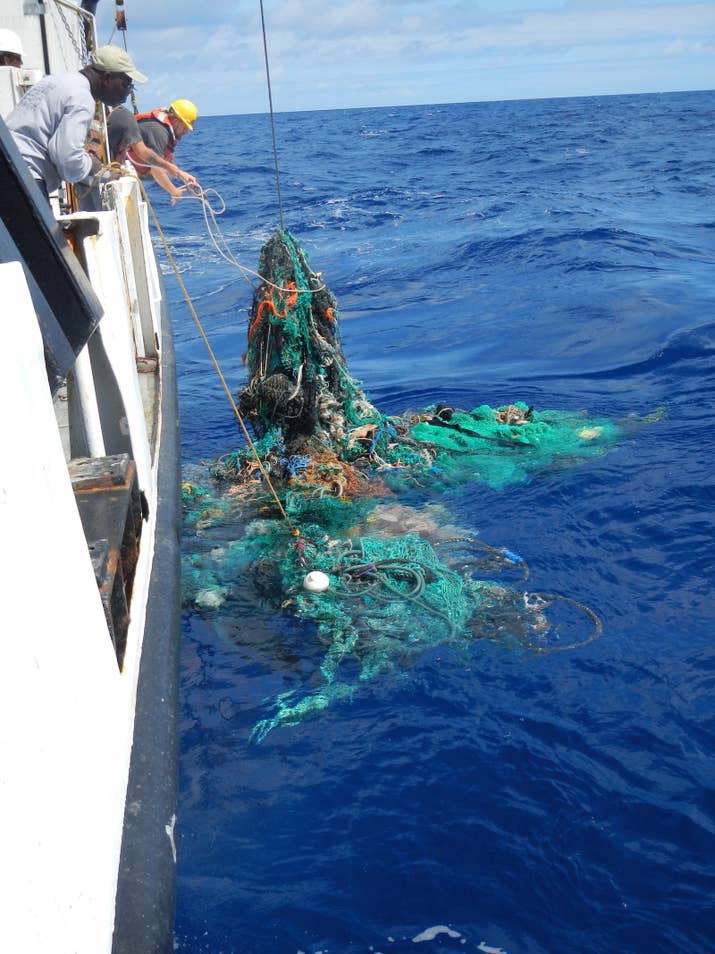 The Ocean Cleanup
The Ocean Cleanup
The Great Pacific Garbage Patch, or GPGP, is not a solid mass, but instead a large area between Hawaii and California where ocean currents have brought together a massive amount of debris that grows denser toward the center of the area.
 The Ocean Cleanup
The Ocean Cleanup
Some of the plastic pieces are very large, while others are tiny fragments called microplastics.
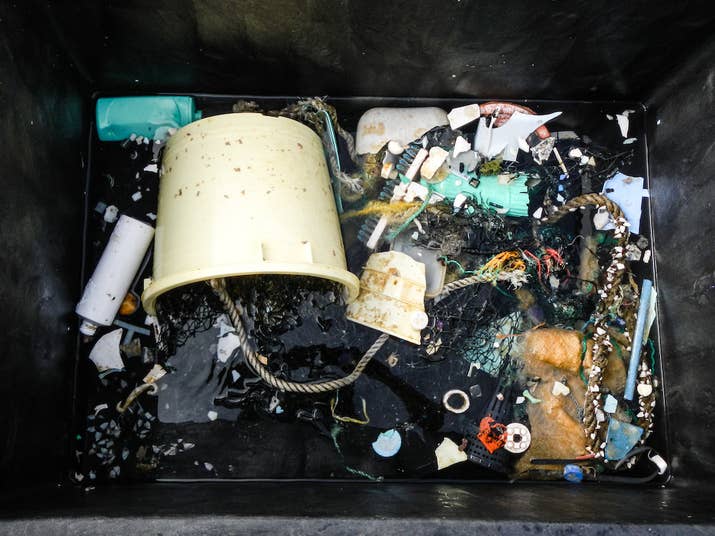
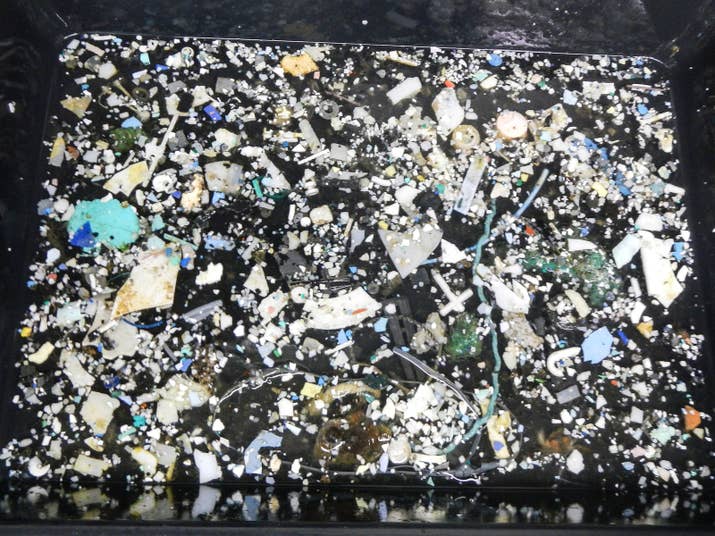 The Ocean Cleanup
The Ocean Cleanup
About 60% of the plastic produced in the world is less dense than seawater, so when it’s introduced to the marine environment, buoyant pieces are often transported by surface currents and winds, researchers say. Some of the debris gets broken down by sun, wind, and waves and sink. But a lot of it remains on the surface.
The mapping study took three years and employed 30 boats and two aircraft to survey the pollution, which was 16 times larger than previously thought, or three times the size of France. It is also estimated to weigh the equivalent of 500 jumbo jets.
 The Ocean Cleanup
The Ocean Cleanup
The study was conducted by the Ocean Cleanup foundation, which was founded by a Dutch teenager Boyan Slat, now 23, in conjunction with researchers in the US, New Zealand, Britain, France, Germany, and Denmark, and published in Scientific Reports.
 Peter Dejong / AP
Peter Dejong / AP
Slat said the data “underlines the urgency of dealing with the plastic pollution problem. Since the results indicate that the amount of hazardous microplastics is set to increase more than tenfold if left to fragment, the time to start is now.”
The trash travels on currents across the ocean, but much of it comes from Asia and fishing activity in the Pacific Ocean, the study found.
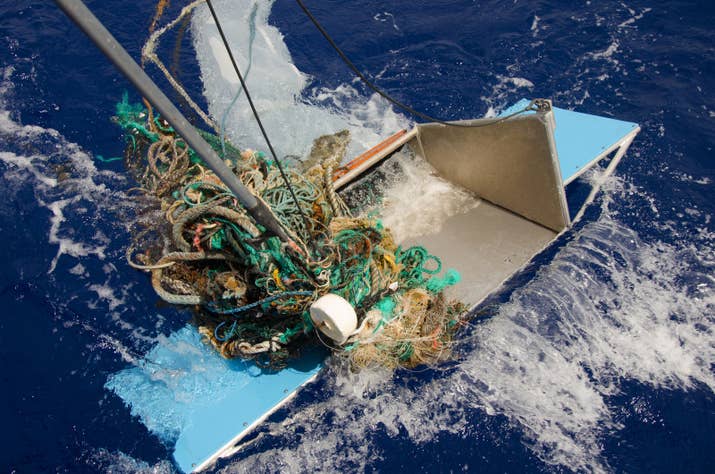 The Ocean Cleanup
The Ocean Cleanup
The study also found that 46% of the Great Pacific Garbage Patch is made up of discarded fishing nets, which are known to entangle whales, seals, and other marine life.
\ Peter Dejong / AP
Peter Dejong / AP
Up to 20% of the debris in the GPGP also came from the 2011 Japanese tsunami, according to the report.
 Peter Dejong / AP
Peter Dejong / AP
Researchers said the data show “plastic pollution levels are increasing exponentially” inside the patch, “and at a faster rate than in surrounding waters.”
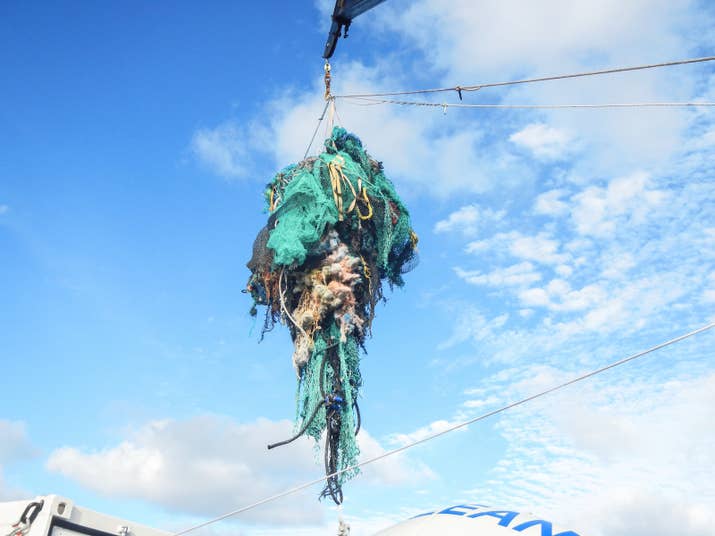 Ocean Cleanup is working on a system to remove the trash and fishing nets, which is set to launch this year.
Ocean Cleanup is working on a system to remove the trash and fishing nets, which is set to launch this year.
Michelle Broder Van Dyke is a reporter and night editor for BuzzFeed News and is based in Hawaii.
Contact Michelle Broder Van Dyke at michelle@buzzfeed.com.